|
Notes: When the Portland branch opened there were no intermediate stations, but a year after line was opened the GWR received a petition for a station at Rodwell to serve the residential area on the south side of the harbour. Although this was approved, nothing was done for several years until December 1869, when Weymouth Town Council wrote to the GWR asking for a date to be set for building to start. The GWR said work would start at once and contractor EC Leaman was appointed to undertake the work.
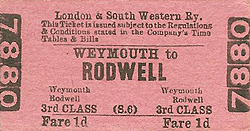 The station was sited in a deep cutting through the Lansdown estate immediately south of the Wyke Road Tunnel. No goods yard was provided as the new station site could not be reached by road vehicles. The station consisted of a single 100ft platform on the down side of the line with access down a long ramp from Wyke Road. The small rectangular station building was of stone construction with a pitched slate roof and a flat canopy. At the bottom of the ramp the entrance to the building was through a central door from the platform; this opened into the booking office. The ticket window was to the right and the ladies’ waiting room/toilet was to the left. Because of the small size of the building there was no general waiting room but there was an alcove with a seat set into the north end wall of the building with another bench seat in the booking office. From photographic evidence and a station plan there appears not to have been a gents’ toilet. The station was sited in a deep cutting through the Lansdown estate immediately south of the Wyke Road Tunnel. No goods yard was provided as the new station site could not be reached by road vehicles. The station consisted of a single 100ft platform on the down side of the line with access down a long ramp from Wyke Road. The small rectangular station building was of stone construction with a pitched slate roof and a flat canopy. At the bottom of the ramp the entrance to the building was through a central door from the platform; this opened into the booking office. The ticket window was to the right and the ladies’ waiting room/toilet was to the left. Because of the small size of the building there was no general waiting room but there was an alcove with a seat set into the north end wall of the building with another bench seat in the booking office. From photographic evidence and a station plan there appears not to have been a gents’ toilet.
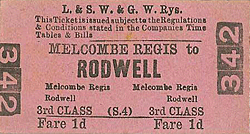 Rodwell station opened without ceremony on Wednesday 1 June 1870 with 14 passengers boarding the first departure for Portland. On its return the train overshot the platform and was forced to shunt back. Until this time branch tickets were checked at a ticket platform at Portland Junction, but with the opening of the new station this platform was closed as tickets could now be checked at Rodwell. Rodwell station opened without ceremony on Wednesday 1 June 1870 with 14 passengers boarding the first departure for Portland. On its return the train overshot the platform and was forced to shunt back. Until this time branch tickets were checked at a ticket platform at Portland Junction, but with the opening of the new station this platform was closed as tickets could now be checked at Rodwell.
A small timber signal box was provided on the platform near the bottom of the ramp in 1892. The platform was extended in January 1894 following residential development. During the first decade of the twentieth century a number of improvements were made to the Portland branch in an attempt to improve the efficiency of the line and attract more customers. One of these was to provide a second platform with a passing loop at Rodwell; work on this was underway in July 1908.
Luckily, during construction of the line the cutting was excavated to a sufficient width to accommodate a second track and platform. The tunnel at the north end was also wide enough for a second track, which was at this time laid through the tunnel as an escape siding from the catch points at the north end of the loop. A new larger standard GWR brick signal box was built on the new platform replacing the earlier box. There was also a standard GWR ‘pagoda’ style waiting shelter and a lattice footbridge spanning the platforms.
The station was always considered one of the most attractive, set in a deep tree-lined cutting and looking more like a GWR country station that one on the edge of a large town. It was always well kept and was a regular winner of ‘Best Kept Station’ competitions. It had colourful flower beds through the spring and summer and even had its own greenhouse at the north end of the down platform.
During the Second World War staff at the station did their bit for the war effort by breeding large rabbits in an enclosure behind the signal box; many of these were sold to the local butcher. During this period the flower beds became allotments. The main station building was destroyed and the signal box damaged during an air raid on 15 April 1941. From this time trains no longer stopped at Rodwell during hours of darkness, to comply with blackout regulations; these remained in force until late 1944. The station building was never replaced.
BRIEF HISTORY OF THE PORTLAND BRANCH
With the advent of railway mania, there were a number of schemes to reach Weymouth which would quickly be developed as a port, opening up trade routes to the Channel Islands. The first of these proposals was a line from Bath to Weymouth in 1836. In 1844 a railway from Salisbury to Weymouth was proposed and, in the same year, the Bristol & Exeter Railway proposed a branch to Weymouth via Yeovil from their recently opened line. This line was later cut back to Yeovil when the Wilts, Somerset & Weymouth Railway (with the support of the GWR) proposed a line from a junction with the GWR at Chippenham to Weymouth via Yeovil and Dorchester.
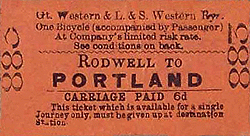 The London & South Western Railway opened their main line from London to Southampton in 1839, and the final scheme was for a line from the LSWR at Southampton via Ringwood and Wimborne to a terminus at Dorchester with a branch to Poole (Bournemouth was not recognised as a town until 1870). Of these schemes, only the Wilts, Somerset & Weymouth Railway (authorised 30 June 1845) and the Southampton & Dorchester Railway (authorised 21 July 1845) were built. The London & South Western Railway opened their main line from London to Southampton in 1839, and the final scheme was for a line from the LSWR at Southampton via Ringwood and Wimborne to a terminus at Dorchester with a branch to Poole (Bournemouth was not recognised as a town until 1870). Of these schemes, only the Wilts, Somerset & Weymouth Railway (authorised 30 June 1845) and the Southampton & Dorchester Railway (authorised 21 July 1845) were built.
Construction of the S&D proceeded rapidly, and the main line and Poole branch opened to passenger traffic on 1 June 1847. Construction of the broad gauge WS&WR was not going so well, however, with continual delays owing to lack of funds. The line was eventually completed to Westbury in 1848 but, by this time, the company was virtually bankrupt; the GWR was forced to step in, taking over both the assets and liabilities and allowing construction to continue. The line did not reach Weymouth until 20 January 1857, and powers to extend the line to Weymouth Quay were allowed to lapse. There was a junction between the two lines at Dorchester with mixed gauge rails laid into Weymouth allowing both the GWR and the LSWR to reach the town.
The opening day failed to attract the expected crowds owing to insufficient notice and passed without ceremony. The usual celebrations took place a week later on 27 January which was declared a local public holiday.
As expected, the railway quickly brought prosperity to Weymouth, which rapidly developed as a both a cross-channel port and holiday resort. Weymouth station was to the north of the town and a mile from the harbour, and it was soon clear that an extension to the quay was desirable, but this would have to wait until construction of the Portland branch.
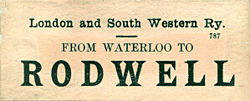 The Isle of Portland is technically not an island as it is attached to the mainland by a remarkable shingle bank known as Chesil Beach which parts company from the mainland near Abbotsbury and meets the ‘Isle’ after eight miles. A tidal lagoon known as the Fleet is on the landward side of Chesil Beach. The landscape of Portland is distinctive, heavily scarred by centuries of quarrying, and with straggling villages built largely to house the quarrymen and their families. The only town on the Isle is Fortuneswell, but the station at the northern edge of the town was to be known as ‘Portland’. The excellent building stone from Portland’s quarries has been exported the world over. Sir Christopher Wren, the architect and Member of Parliament for Weymouth, used six million tons of white Portland limestone to rebuild destroyed parts of London – most notably St Paul’s Cathedral - after the Great Fire of London of 1666. It was again used to help rebuild London after WWII and features in many landmark buildings across the country. Portland Harbour, between Portland and Weymouth, is one of the largest man-made harbours in the world. It was created for the Royal Navy by the building of stone breakwaters between 1848 and 1905. The Royal Navy Dockyard played prominent roles during the First and Second World Wars; ships of the Royal Navy and NATO countries exercised in its waters until 1995. The Isle of Portland is technically not an island as it is attached to the mainland by a remarkable shingle bank known as Chesil Beach which parts company from the mainland near Abbotsbury and meets the ‘Isle’ after eight miles. A tidal lagoon known as the Fleet is on the landward side of Chesil Beach. The landscape of Portland is distinctive, heavily scarred by centuries of quarrying, and with straggling villages built largely to house the quarrymen and their families. The only town on the Isle is Fortuneswell, but the station at the northern edge of the town was to be known as ‘Portland’. The excellent building stone from Portland’s quarries has been exported the world over. Sir Christopher Wren, the architect and Member of Parliament for Weymouth, used six million tons of white Portland limestone to rebuild destroyed parts of London – most notably St Paul’s Cathedral - after the Great Fire of London of 1666. It was again used to help rebuild London after WWII and features in many landmark buildings across the country. Portland Harbour, between Portland and Weymouth, is one of the largest man-made harbours in the world. It was created for the Royal Navy by the building of stone breakwaters between 1848 and 1905. The Royal Navy Dockyard played prominent roles during the First and Second World Wars; ships of the Royal Navy and NATO countries exercised in its waters until 1995.
During the nineteenth century, two independent railway networks the ‘Merchants’ and the ’Admiralty’ were laid to transport stone from the quarries. The Merchants’ Railway was the earliest—it opened in 1826 (one year after the Stockton & Darlington Railway) and ran from the quarries at the north of Tophill to a pier at Castletown (sometimes spelt Castleton), from where the Portland stone was shipped around the country. The only means of transporting the stone at that time was by sea. As soon as the railway reached Weymouth schemes evolved for a line from Weymouth to Portland. The first of these came in November 1857 but received little support and was quickly dropped. There were a further two proposals in 1861, one from a local consortium, and eventually both groups joined forces with a meeting being held in Weymouth on 7 October 1861 to thrash out the best route for the proposed Weymouth & Portland Railway, which was also to include two horse-drawn tramways: one to Weymouth Quay and the other from Portland to the Merchants’ Railway at Castletown. The GWR supported the scheme and, although the Weymouth harbour tramway also received generous local support, there was less enthusiasm for the Portland railway with some people concerned that any future development of a port at Portland might, in time, become a competitor to Weymouth. As the two lines were embodied in the same scheme this opposition came to nothing, and a Bill was quickly put before Parliament for a single mixed gauge line which would be operated jointly by the GWR & LSWR.
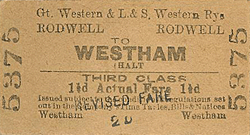 The Weymouth & Portland Railway Act received the Royal Assent on 30 June 1862. Sufficient land was purchased to allow for the track to be doubled at a future date, and construction started in December 1862 with the intention of completing the line by January 1864. The contractor was John Aird & Company, one of the leading British civil engineering businesses based in London: the company had relocated Crystal Palace to Sydenham in 1851. Their expected completion date was somewhat optimistic, however. The Weymouth & Portland Railway Act received the Royal Assent on 30 June 1862. Sufficient land was purchased to allow for the track to be doubled at a future date, and construction started in December 1862 with the intention of completing the line by January 1864. The contractor was John Aird & Company, one of the leading British civil engineering businesses based in London: the company had relocated Crystal Palace to Sydenham in 1851. Their expected completion date was somewhat optimistic, however.
By early October 1863 construction was progressing well. The Backwater viaduct was almost complete, and the second viaduct over the Fleet at Ferrybridge was half built. The only other major engineering features - a cut-and-cover tunnel taking the line under Wyke Road at Rodwell and the 700ft-long Marsh embankment which took the line over a former inlet of the harbour - were progressing well. The Marsh embankment was completed by the end of February 1864 with the first train running over the entire length of the line on 5 May. This consisted of a broad gauge engine which hauled standard gauge wagons conveying company personnel.
The Board of Trade inspection was carried out by Col Yolland on 19 May 1864. The inspector’s report was particularly critical of the two viaducts which he considered to be ‘very unsatisfactory’ for many reasons. Col Yolland was equally scathing about the signalling arrangements at Portland Junction in Weymouth, citing numerous other areas where improvements were required.
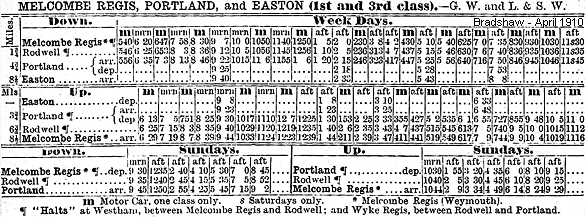
Permission to open the line was refused and, after some remedial work had been completed, a second inspection took place on 6 August 1864. The inspector noted some strengthening of the viaducts but many of the other necessary improvements had not been carried out, including the signalling arrangements at Portland Junction which were still wholly inadequate; once again the inspector refused to sanction the opening of the line. It was soon clear that the GWR, LSWR and the local company were in complete disagreement about the provision of passenger facilities at Weymouth. The Weymouth & Portland board was of the opinion that it was not obliged to provide a separate station on the new line, while the LSWR did want a separate branch station to be paid for by the W&P. The GWR was happy to use its existing station but demanded payment which was resisted by the W&P board. Disagreements continued for over a year while the line lay idle. Eventually the dispute went to arbitration. The ruling was that the W&P should use the existing station, for which they should pay the GWR £2,600; they were also ordered to pay the GWR for land and improvements to the junction between the branch and the main line in order to pass the next inspection.
Despite this ruling, the three companies were still unable to agree over the exact detail of the new arrangements. The Weymouth Quay tramway, which was now complete and ready for opening with horse-drawn traffic, was unable to open as it was an integral part of the Portland line and, for legal reasons, could not be opened before the branch.
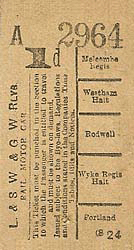 The three parties eventually settled their longstanding dispute, and the Board of Trade sanctioned the opening of the line. Goods traffic started on 9 October 1865, and the Portland branch finally opened to passenger traffic with little ceremony on Monday 16 October. There was ambitious provision of 11 trains in each direction on weekdays and six on Sundays. The company’s initial optimism did not last long, and within a few weeks three of the weekday trains and one of the Sunday trains were withdrawn. Initially the passenger service was run by the LSWR. The three parties eventually settled their longstanding dispute, and the Board of Trade sanctioned the opening of the line. Goods traffic started on 9 October 1865, and the Portland branch finally opened to passenger traffic with little ceremony on Monday 16 October. There was ambitious provision of 11 trains in each direction on weekdays and six on Sundays. The company’s initial optimism did not last long, and within a few weeks three of the weekday trains and one of the Sunday trains were withdrawn. Initially the passenger service was run by the LSWR.
A year after the opening of the line there was a public petition for the provision of an intermediate station at Rodwell. This was approved, and work started in January 1870 with the station opening on 1 July.
It was clear, even before the Portland branch opened, that the days of broad gauge lines were numbered and the Wilts, Somerset & Weymouth line was converted to standard gauge between 18 and 22 June 1874. Both the Portland branch and the Weymouth Quay tramway were mixed gauge, so there was no hurry to remove the third track as this operation would cause little disruption to the service. After the end of broad gauge the LSWR and GWR worked the line for alternate periods of twelve months.
In November 1866 another line, the Easton & Church Hope, on the other side of the Isle of Portland, was proposed. Initially it was to link Portland's quarries to the sea. The Easton & Church Hope Railway Act received Royal Assent on 25 July 1867. Despite this Act, no work was ever started; the powers eventually lapsed in 1872, and the line lay dormant for eleven years. In the meantime an Admiralty Railway was built from the Weymouth & Portland line at Portland to a pier on the new Admiralty Breakwater, mainly to supply coal to ships. The Easton & Church Hope project was revived with hopes of running powers over this line, but although construction was authorised in 1884, none was undertaken until 1888. When it did start, the work involved blasting through 3½ miles of solid rock in a task taking 12 years and a number of parliamentary extensions. A delay caused by the need to bring the Admiralty stretch up to passenger standard followed.
On 5 August 1897 the GWR and LSWR reached an agreement with the ECHR requiring the local company to provide a new station at Portland, adjacent to the existing station but on a new alignment and, once complete, the new line would be operated and staffed by the joint companies. Easton station was completed in 1900 while construction of the new station at Portland was underway.
The ECH line was inspected by Lt-Col Yorke for the Board of Trade on 3 July 1900. Although he considered the Easton line acceptable the Admiralty line over which trains would have to pass was not adequate for passenger use. In his report he stated, ‘The line is not sufficiently complete to use, and therefore I am unable to recommend its opening’. As the Board of Trade sanction was required only for passenger traffic the company decided to open the line to goods traffic on 1 October 1900 in order to generate much-needed revenue.
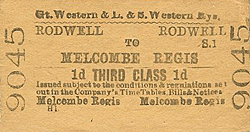 After a few weeks there had been little stone traffic over the line with no sign of future improvement. After a visit by representatives of the GWR and LSWR they concluded that the reason for lack of stone traffic was twofold: the loading depots were not close enough to the quarries and the rates being charged were too high. Before the ECHR was built there were already adequate means of transport for the stone. The Merchants’ Railway ran directly into many of the quarries whilst others were served by traction engines which hauled stone to a loading point on the Merchants’ Railway, or directly to Barness’ yard alongside Portland station. At that time the Admiralty terminated its maintenance agreement with the GWR and LSWR, forcing the E&CHR to carry out the work itself. After a few weeks there had been little stone traffic over the line with no sign of future improvement. After a visit by representatives of the GWR and LSWR they concluded that the reason for lack of stone traffic was twofold: the loading depots were not close enough to the quarries and the rates being charged were too high. Before the ECHR was built there were already adequate means of transport for the stone. The Merchants’ Railway ran directly into many of the quarries whilst others were served by traction engines which hauled stone to a loading point on the Merchants’ Railway, or directly to Barness’ yard alongside Portland station. At that time the Admiralty terminated its maintenance agreement with the GWR and LSWR, forcing the E&CHR to carry out the work itself.
With less than the expected revenue the company had run out of money, and two of its directors were appointed as receivers. In order to save the company it was important to get the passenger service running as quickly as possible which would mean all the improvements required by Lt-Col Yorke would have to be completed. Lt-Col Yorke returned on 19 March 1902 and found that once again the work had not been done to his satisfaction, and he returned to London declining a lunch that had been arranged for him.
While the new station at Portland was under construction, a temporary timber platform was built on the curve between Portland station and Castletown Road bridge. This was completed and, once again, Lt-Col returned on 14 August 1902. Although he was not happy with a platform on such a sharp curve he was prepared to accept it as it was only a temporary structure, although he was highly critical that the new station had not yet been completed. As other required improvements had also not been implemented he again refused to recommend the opening of the line, returning for a fourth and final time on 14 August 1902. At last he was prepared to sanction the opening of the line for passenger traffic, and the first train ran on 1 September 1902. The physical connection between the Weymouth & Portland line and the ECHR had no signalling and was still considered part of a siding to Castletown, so through traffic was not permitted, with passengers having to change at Portland and walk to the temporary platform. Despite these inconvenient arrangements 551 passengers travelled over the line on the first day but bookings quickly dropped on the line that had taken over 35 years and nine Acts of Parliament to build.
Although the line was still owned by the three original companies - the Weymouth & Portland, the Easton & Church Hope, and the Admiralty railways - the entire route between Weymouth and Easton was now worked jointly by the GWR and LSWR, and the line would continue in the same ‘make do and mend’ fashion until Nationalisation.
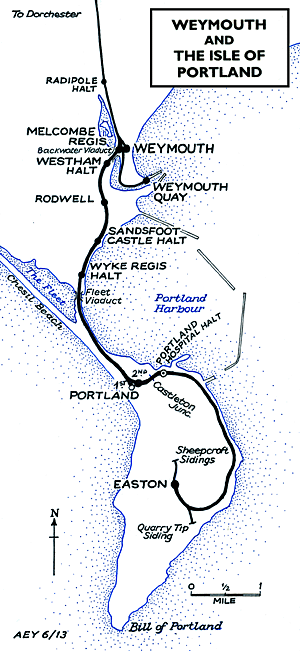 In 1903 a new station at Wyke Regis was announced to serve the growing village around Whitehead’s factory which had opened in 1891 and was now employing a considerable local workforce. No construction took place, which is surprising as the factory was sited next to the line and had a siding running into it. Work on the new station at Portland was still progressing, albeit very slowly. In 1903 a new station at Wyke Regis was announced to serve the growing village around Whitehead’s factory which had opened in 1891 and was now employing a considerable local workforce. No construction took place, which is surprising as the factory was sited next to the line and had a siding running into it. Work on the new station at Portland was still progressing, albeit very slowly.
Goods traffic on the Easton line remained disappointing with two trains a day, later reduced to one, as were passenger receipts from the four daily trains. These were inconveniently timed for commuters from Easton with the first train of the day at 9.05am. By 1905 the passenger service had been cut back to three daily trains with a late evening service on Wednesdays and Saturdays. There were public demands for a connecting train for the afternoon 3.25 service from Portland to Weymouth. The Easton & Church Hope secretary pointed out that the line was not paying its way, and if people continued to press for an improvement to the service it would either be cut back further or withdrawn altogether!
The new Portland station finally opened on 7 May 1905, and the old terminus was retained as a goods depot.
Following the success of rail-motor services introduced between Weymouth and Dorchester on 1 May 1905, the GWR announced in September that it would be launching an hourly rail-motor service between Weymouth and Portland at the start of 1906. This was later revised to include Easton, but the service failed to materialise.
In May 1906 the GWR outlined proposals to replace the weakened timber viaduct over the Backwater and, at the same time, build a separate station for the sole use of branch trains. This was to be constructed on land reclaimed from the Backwater. Work on the new five-span lattice girder bridge started in September 1907 and was completed in January 1909. Once again Lt-Col Yorke carried out the inspection for the Board of Trade; it was quickly passed fit for use with the first train running over it on 7 February.
Removal of the old viaduct was quickly carried out as the site at the Weymouth end was required for the approach road for the new station which was nearing completion. The station opened on 30 May 1909 and, although adjacent to the goods yard at Weymouth, it was given the name Melcombe Regis. From that date, all branch trains ran to and from Melcombe Regis, removing the awkward reversal into Weymouth.
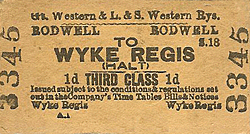 In June 1909 Wyke Regis finally received its long awaited halt, and a second halt was opened at Westham on the north side of the new viaduct, both being provided as part of a GWR plan to fight road competition. After being inspected by Col Von Donop for the Board of Trade they were passed fit for use. They opened on 1 July with the introduction of a greatly improved service between Weymouth and Portland with 13 trains in each direction and seven on Sundays, supplemented by nine rail-motors on weekdays only. Initially the two new halts were served only by the rail-motors but from 1913 Sunday trains also called. In June 1909 Wyke Regis finally received its long awaited halt, and a second halt was opened at Westham on the north side of the new viaduct, both being provided as part of a GWR plan to fight road competition. After being inspected by Col Von Donop for the Board of Trade they were passed fit for use. They opened on 1 July with the introduction of a greatly improved service between Weymouth and Portland with 13 trains in each direction and seven on Sundays, supplemented by nine rail-motors on weekdays only. Initially the two new halts were served only by the rail-motors but from 1913 Sunday trains also called.
With the outbreak of war on 3 August 1914 all railways came under Government control two days later. The Portland branch would soon be playing an important part in the war effort bringing coal for the ships in Portland Harbour. From 1915 casualties began landing in Portland from where special ambulance trains would take them to hospitals around the country. Ambulance trains also brought casualties from the Grand Fleet based at Scapa Flow to the Royal Naval Hospital at Portland. While many branch lines saw a rundown of services during the war the Portland branch maintained a good service, with more people being employed at the dockyard loading munitions and carrying out repairs to damaged ships. In 1917 there were still 20 outward journeys to Portland and 19 return journeys with four of the trains running on to Easton. In the later years of the war a large quantity of stone waste was transported by rail to Southampton where a train ferry terminal was under construction.
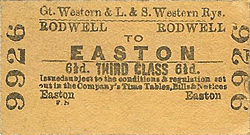 The Railways Act 1921, also known as the Grouping Act, was intended to stem the losses being made by many of the country’s 120 railway companies, to move the railways away from internal competition, and to retain some of the benefits which the country had derived from a Government-controlled railway during and after the Great War. The Weymouth & Portland and the Easton & Church Hope companies were not included in the grouping, but of the joint leasing companies only the GWR retained its identity as one of the 'Big Four' whilst the LSWR became part of the Southern Railway. Apart from the change of name, joint operation continued as before and little on the branch changed. The Railways Act 1921, also known as the Grouping Act, was intended to stem the losses being made by many of the country’s 120 railway companies, to move the railways away from internal competition, and to retain some of the benefits which the country had derived from a Government-controlled railway during and after the Great War. The Weymouth & Portland and the Easton & Church Hope companies were not included in the grouping, but of the joint leasing companies only the GWR retained its identity as one of the 'Big Four' whilst the LSWR became part of the Southern Railway. Apart from the change of name, joint operation continued as before and little on the branch changed.
In 1922 there were 18 daily trains in each direction with five extended to Easton. Once again these trains were badly timed with the first train leaving Easton at 9.25am ensuring that the line could not be used by commuters. This problem was finally resolved in the summer of 1924 when an early morning train brought the daily tally at this end of the branch to six.
In June 1927 the joint leasing companies looked into the high cost of running the line; they produced a report which stated, ‘The freight train traffic on the Easton & Church Hope Line, consisting mainly of stone outwards and coal inwards, is of a weighty character, and the limitations of the loads imposed by the gradients involves the employment of locomotive power beyond the average. The freight traffic has, however, a heavy contributive value to the main line owing to the long haulage of the stone and coal. The passenger traffic of this line consists principally of workmen employed in the various Naval establishments and quarries who travel in considerable numbers at certain times of the day, necessitating the provision of an unusual number of coaches for such a short mileage. Ticket issue is mainly local at short fares, and the passenger traffic has therefore little contributive value so far as main lines are concerned. There is heavy road competition along the whole line of route, the motor omnibuses having the advantage of passing through the principal business and residential areas of Weymouth and Portland, whereas the stations at Easton and Melcombe Regis are not favourably situated for the attraction of local traffic.'
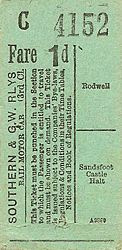 They were most concerned about the Portland - Easton line where a traffic census made in March 1927 showed that this part of the line carried only 800 passengers a week. The first daily service carried about 60 with around the same number returning on the 4.30pm; many of these were pupils attending Weymouth Grammar School. Most of the other trains (Monday - Friday) carried about ten passengers. It was suggested that savings could be made by closing the Easton section to passenger traffic and replacing the service with a railway-owned bus service. Special passenger excursions could still be run into Easton in holiday periods when there was likely to be a greater demand. There were no recommendations about the Weymouth - Portland line other than a reduction in the Sunday service. None of the cost saving measures was implemented. They were most concerned about the Portland - Easton line where a traffic census made in March 1927 showed that this part of the line carried only 800 passengers a week. The first daily service carried about 60 with around the same number returning on the 4.30pm; many of these were pupils attending Weymouth Grammar School. Most of the other trains (Monday - Friday) carried about ten passengers. It was suggested that savings could be made by closing the Easton section to passenger traffic and replacing the service with a railway-owned bus service. Special passenger excursions could still be run into Easton in holiday periods when there was likely to be a greater demand. There were no recommendations about the Weymouth - Portland line other than a reduction in the Sunday service. None of the cost saving measures was implemented.
In 1931 the joint operation of the line ceased with the Southern Railway taking sole operation of the line, although the three original companies retained ownership.
For many years Portland had good bus services, and in an attempt to counter increased competition a third halt between Rodwell and Wyke Regis was provided for the benefit of tourists visiting Henry VIII's castle: Sandsfoot Castle Halt opened on 1 August 1932.
In 1939 war with Germany was once again approaching. As tension increased the Emergency Powers (Defence) Act received the Royal Assent on 24 August 1939, a week before Germany invaded Poland. This once again brought the railways under state control. A plan for mass evacuation of the cities was put in place in September 1939. 774 evacuees from London arrived in Portland by train, but they were quickly moved elsewhere once it was realised that the Naval facilities at Portland would be a major target! In fact many of the likely targets for air attack were sited close to the Portland branch: these included Weymouth with its commercial harbour and ship repair yards, the naval harbour and dockyard at Portland and Whitehead's torpedo factory at Wyke Regis.
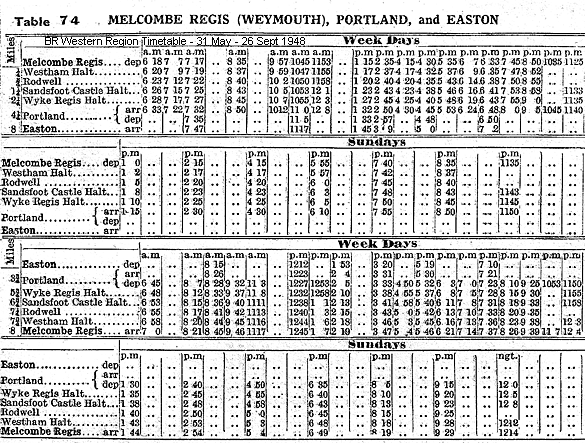
As in the Great War, the railway was to play a vital role in the war effort carrying naval stores and troops. The passenger service on the line was initially drastically cut, but by January 1940 most services were reinstated with 21 trains in each direction, seven of which were extended to Easton. On Sunday 11 trains ran, but all of them terminated at Portland. Later in the war the service was cut back to 14 a day.
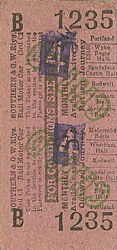 A number of bombs fell on the railway during the war. The first came on 11 August 1940 during the Battle of Britain; the Portland signal box took a direct hit from a German bomber, killing the signalman. As the war progressed a number of guns manned by the Home Guard were emplaced along the railway line to defend strategic locations including the Marsh embankment, Ferrybridge and Whitehead’s torpedo factory. On 15 April 1941 the main station building at Rodwell was destroyed and one member of staff killed during an air raid. After that raid, trains stopped at Rodwell during daylight hours only owing to blackout restrictions which remained in force until late 1944. A number of bombs fell on the railway during the war. The first came on 11 August 1940 during the Battle of Britain; the Portland signal box took a direct hit from a German bomber, killing the signalman. As the war progressed a number of guns manned by the Home Guard were emplaced along the railway line to defend strategic locations including the Marsh embankment, Ferrybridge and Whitehead’s torpedo factory. On 15 April 1941 the main station building at Rodwell was destroyed and one member of staff killed during an air raid. After that raid, trains stopped at Rodwell during daylight hours only owing to blackout restrictions which remained in force until late 1944.
Passenger services were withdrawn from the Easton section of the line on 11 November 1940 but were reinstated during the summer months from 1941 to 1944.
The railway had a part to play in the build up to D-Day and by mid March 1944 it was in use 24 hours a day. On 6 June 1944 418,585 American troops and 144,093 vehicles were embarked from Portland for the Normandy beaches. After D-Day the traffic started to flow in reverse, a transit camp for prisoners-of-war being set up on the Royal Naval sports ground alongside Portland station. From there POWs were taken to Devizes by special trains.
From 1 January 1945 a full passenger service on the Easton section of the line was reinstated with three trains a day, later increased to four.
Although the war was over, railways remained under government until they were nationalised as part of the July 1947 Transport Act. This brought an end to the private ownership of the line. From 1 January 1948 the Portland line came under the control of the Southern Region of British Railways. The Weymouth & Portland Railway was wound up in August 1948.
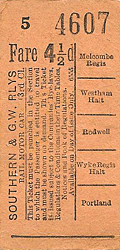 As with many branch lines the Portland branch had, for many years, been experiencing competition from buses. These generally provided a more convenient service, taking passengers closer to their destination. By the 1950s there was a bus every 10 minutes between Weymouth and Portland and every 20 minutes to Easton; the railway had no chance of competing. By this time many of the regular passengers were children going to Weymouth Grammar School, mothers with prams, and service personnel who were travelling beyond Weymouth. It therefore came as no surprise when closure of the Portland line to passengers was proposed in September 1950. Portland and Weymouth councils both sent representatives to the Transport Users’ Consultative Committee early in November to object to the closure, but the committee was satisfied with the alternative travel arrangements already in place or which could be implemented. In 1950 British Railways had made a loss of £14,000 on the passenger service but, despite appeals from the two councils, it was announced that the line would close to passengers on 3 March 1952. As with many branch lines the Portland branch had, for many years, been experiencing competition from buses. These generally provided a more convenient service, taking passengers closer to their destination. By the 1950s there was a bus every 10 minutes between Weymouth and Portland and every 20 minutes to Easton; the railway had no chance of competing. By this time many of the regular passengers were children going to Weymouth Grammar School, mothers with prams, and service personnel who were travelling beyond Weymouth. It therefore came as no surprise when closure of the Portland line to passengers was proposed in September 1950. Portland and Weymouth councils both sent representatives to the Transport Users’ Consultative Committee early in November to object to the closure, but the committee was satisfied with the alternative travel arrangements already in place or which could be implemented. In 1950 British Railways had made a loss of £14,000 on the passenger service but, despite appeals from the two councils, it was announced that the line would close to passengers on 3 March 1952.
There was to be no stay of execution as the inevitable was accepted, and many local people took an opportunity to travel on the railway for the last time with 2,884 passengers travelling during the last week, 858 of them on Saturday 1 March. The 2.25pm train from Melcombe Regis to Easton, which usually consisted of a two-coach set, was replaced with six coaches of main line stock double-headed by two tank engines. The final passenger train for Portland left Melcombe Regis just before midnight on Sunday 2 March without ceremony and with only six passengers!
There was never any suggestion that the line should close to goods traffic as, at this time, it was still very profitable. There were still regular passenger trains carrying military personnel to Portland Dockyard, special works excursions and railtours. In February 1954 Weymouth Borough Council approached the Transport Users’ Consultative Committee to discuss the possibility of reopening the branch; nothing came of it. Although officially closed, Melcombe Regis did see some passenger traffic as an overflow platform for Weymouth during busy periods.
.gif) By the early 1960s goods traffic was in decline. During 1962 11,445 tons of goods were dispatched from Portland, out of which total 9,800 tons was stone, whilst of the 8,721 tons received at Portland. 6,177 were coal and coke. In 1963 the annual earnings of the branch amounted to £6,300, but operating expenses totalled £12,500 with a further £92,450 required for maintaining the line during the next five years; this included the cost of replacing the Fleet viaduct. It therefore came as no surprise when closure was proposed in November 1964. By the early 1960s goods traffic was in decline. During 1962 11,445 tons of goods were dispatched from Portland, out of which total 9,800 tons was stone, whilst of the 8,721 tons received at Portland. 6,177 were coal and coke. In 1963 the annual earnings of the branch amounted to £6,300, but operating expenses totalled £12,500 with a further £92,450 required for maintaining the line during the next five years; this included the cost of replacing the Fleet viaduct. It therefore came as no surprise when closure was proposed in November 1964.
Early in 1965 a freight concentration scheme for Weymouth was announced. This was in line with the Beeching plan which favoured large goods depots from where road deliveries would be made to the surrounding towns. As part of this scheme, complete closure of the Portland branch was scheduled for 1 February, although this was put back to allow work on the additional facilities at Weymouth goods depot to be completed.
With closure imminent, the South & West Railway Society of Weymouth arranged for three specials to run over the line on 27 March to give local people and enthusiasts a last opportunity to travel on the railway. 1,056 tickets were sold and the three trains were packed.
The official closure date was 5 April 1965, but a number of trains used the line after this date to collect wagons and tools, and the last train to run the full length of the line was on Friday 9 April. The viaduct over the Backwater was then used to stable condemned wagons awaiting disposal. The last of these was removed on 10 January 1966, and on 26 February a stop block was installed at the junction bringing complete closure to the line.
Track-lifting started in August 1966, and by early 1967 all the track had been removed between Easton and the junction with the line into the Dockyard. With the removal of all the sidings this just left a single line running between Weymouth and the Dockyard. This was kept in place at the request of the Ministry of Transport pending possible need by the Admiralty, but it proved not to be required, and by the end of 1969 all the track had been lifted back to Westham Halt.
The trackbed between Ferrybridge and Melcombe Regis was sold to Portland Borough Council on 19 November 1974, and the same month work started on demolishing the viaduct over the Backwater. In the 1970s Dorset County Council proposed that a section of the route between Melcombe Regis and Ferrybridge should be used for a relief road, but in March 1978 Weymouth & Portland Borough Counci1 opposed the plan. During 1980 plans for the construction of a miniature railway along this section were put forward. Had it been built, this line would have attempted to provide an alternative form of public transport along the former railway route, similar to the miniature trams running on the trackbed of the former Seaton branch in Devon. The Weymouth plan was soon withdrawn, and a revised one was later rejected by the Borough Council.
.gif) Through the 1980s the old railway line grew in popularity with local residents as an informal footpath between Abbotsbury Road and Ferrybridge. In 1997 a proposal for a cycleway and footpath along the former railway line was included in the Weymouth & Portland Local Plan. After being subject to full public and statutory consultation, the Plan was formally adopted by the Borough Council, and work to develop the trail commenced. The partners included Weymouth & Portland Borough Council, Dorset County Council and West Weymouth Conservation Society working with South West of England Regional Development Agency. Through the 1980s the old railway line grew in popularity with local residents as an informal footpath between Abbotsbury Road and Ferrybridge. In 1997 a proposal for a cycleway and footpath along the former railway line was included in the Weymouth & Portland Local Plan. After being subject to full public and statutory consultation, the Plan was formally adopted by the Borough Council, and work to develop the trail commenced. The partners included Weymouth & Portland Borough Council, Dorset County Council and West Weymouth Conservation Society working with South West of England Regional Development Agency.
Work commenced in 1999 and a cycle/walkway was constructed with a tarmac surface and access points to existing roads. The ‘Rodwell Trail’ was officially opened in April 2000. In June 2000 The Weymouth & Portland Environmental Partnership was awarded a Civic Society Special Award 2000 for the creation of the trail. Between 2003 and 2004 the first meetings of Friends of Rodwell Trail were held, and groups of willing volunteers undertook clearance of overgrown vegetation and litter-picking. Weymouth & Portland Borough Council and West Weymouth Conservation Society funded the purchase and installation of litter and dog bins. Although they did not possess them when they were open, reproduction British Railways totem signs have been mounted on
the three halts.
Tickets from Michael Stewart except 1107, 0030 & 0055 Brian Halford, Route map drawn by Alan Young, Bradshaw and BR timetable from Chris Totty.
Sources:
To see other stations on the Portland & Easton branch click on the station name: Weymouth, Melcombe Regis, Westham Halt, Sandsfoot Castle Halt, Wyke Regis Halt, Portland 1st, Portland 2nd, Portland Hospital, Portland Dockyard & Easton
See also Weymouth Quay |


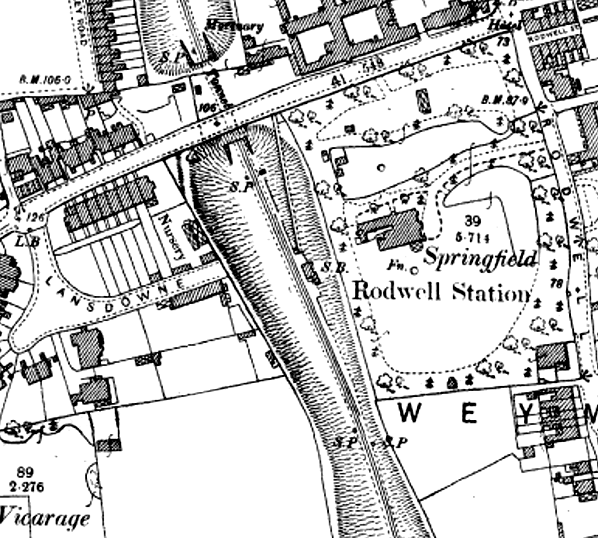
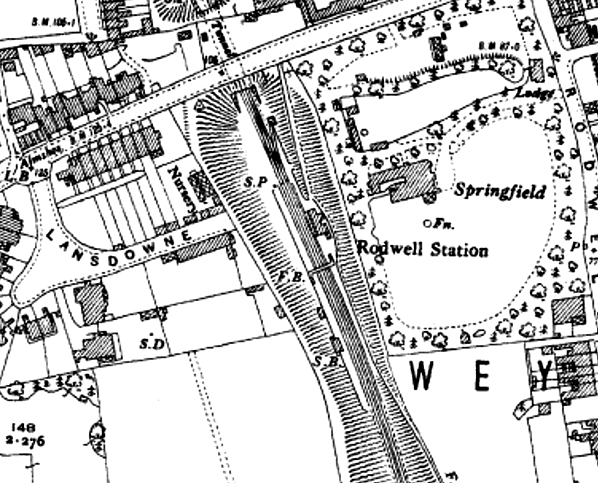
old4.jpg)
old5.jpg)
old9.jpg)
old8.jpg)
old15.jpg)
old7.jpg)
old1.jpg)
old13.jpg)
old2.jpg)
4.jpg)
2.jpg)
7.jpg)
 The station was sited in a deep cutting through the Lansdown estate immediately south of the Wyke Road Tunnel. No goods yard was provided as the new station site could not be reached by road vehicles. The station consisted of a single 100ft platform on the down side of the line with access down a long ramp from Wyke Road. The small rectangular station building was of stone construction with a pitched slate roof and a flat canopy. At the bottom of the ramp the entrance to the building was through a central door from the platform; this opened into the booking office. The ticket window was to the right and the ladies’ waiting room/toilet was to the left. Because of the small size of the building there was no general waiting room but there was an alcove with a seat set into the north end wall of the building with another bench seat in the booking office. From photographic evidence and a station plan there appears not to have been a gents’ toilet.
The station was sited in a deep cutting through the Lansdown estate immediately south of the Wyke Road Tunnel. No goods yard was provided as the new station site could not be reached by road vehicles. The station consisted of a single 100ft platform on the down side of the line with access down a long ramp from Wyke Road. The small rectangular station building was of stone construction with a pitched slate roof and a flat canopy. At the bottom of the ramp the entrance to the building was through a central door from the platform; this opened into the booking office. The ticket window was to the right and the ladies’ waiting room/toilet was to the left. Because of the small size of the building there was no general waiting room but there was an alcove with a seat set into the north end wall of the building with another bench seat in the booking office. From photographic evidence and a station plan there appears not to have been a gents’ toilet. Rodwell station opened without ceremony on Wednesday 1 June 1870 with 14 passengers boarding the first departure for Portland. On its return the train overshot the platform and was forced to shunt back. Until this time branch tickets were checked at a ticket platform at Portland Junction, but with the opening of the new station this platform was closed as tickets could now be checked at Rodwell.
Rodwell station opened without ceremony on Wednesday 1 June 1870 with 14 passengers boarding the first departure for Portland. On its return the train overshot the platform and was forced to shunt back. Until this time branch tickets were checked at a ticket platform at Portland Junction, but with the opening of the new station this platform was closed as tickets could now be checked at Rodwell. The London & South Western Railway opened their main line from London to Southampton in 1839, and the final scheme was for a line from the LSWR at Southampton via Ringwood and Wimborne to a terminus at Dorchester with a branch to Poole (Bournemouth was not recognised as a town until 1870). Of these schemes, only the Wilts, Somerset & Weymouth Railway (authorised 30 June 1845) and the Southampton & Dorchester Railway (authorised 21 July 1845) were built.
The London & South Western Railway opened their main line from London to Southampton in 1839, and the final scheme was for a line from the LSWR at Southampton via Ringwood and Wimborne to a terminus at Dorchester with a branch to Poole (Bournemouth was not recognised as a town until 1870). Of these schemes, only the Wilts, Somerset & Weymouth Railway (authorised 30 June 1845) and the Southampton & Dorchester Railway (authorised 21 July 1845) were built. The Isle of Portland is technically not an island as it is attached to the mainland by a remarkable shingle bank known as Chesil Beach which parts company from the mainland near Abbotsbury and meets the ‘Isle’ after eight miles. A tidal lagoon known as the Fleet is on the landward side of Chesil Beach. The landscape of Portland is distinctive, heavily scarred by centuries of quarrying, and with straggling villages built largely to house the quarrymen and their families. The only town on the Isle is Fortuneswell, but the station at the northern edge of the town was to be known as ‘Portland’. The excellent building stone from Portland’s quarries has been exported the world over. Sir Christopher Wren, the architect and Member of Parliament for Weymouth, used six million tons of white Portland limestone to rebuild destroyed parts of London – most notably St Paul’s Cathedral - after the Great Fire of London of 1666. It was again used to help rebuild London after WWII and features in many landmark buildings across the country. Portland Harbour, between Portland and Weymouth, is one of the largest man-made harbours in the world. It was created for the Royal Navy by the building of stone breakwaters between 1848 and 1905. The Royal Navy Dockyard played prominent roles during the First and Second World Wars; ships of the Royal Navy and NATO countries exercised in its waters until 1995.
The Isle of Portland is technically not an island as it is attached to the mainland by a remarkable shingle bank known as Chesil Beach which parts company from the mainland near Abbotsbury and meets the ‘Isle’ after eight miles. A tidal lagoon known as the Fleet is on the landward side of Chesil Beach. The landscape of Portland is distinctive, heavily scarred by centuries of quarrying, and with straggling villages built largely to house the quarrymen and their families. The only town on the Isle is Fortuneswell, but the station at the northern edge of the town was to be known as ‘Portland’. The excellent building stone from Portland’s quarries has been exported the world over. Sir Christopher Wren, the architect and Member of Parliament for Weymouth, used six million tons of white Portland limestone to rebuild destroyed parts of London – most notably St Paul’s Cathedral - after the Great Fire of London of 1666. It was again used to help rebuild London after WWII and features in many landmark buildings across the country. Portland Harbour, between Portland and Weymouth, is one of the largest man-made harbours in the world. It was created for the Royal Navy by the building of stone breakwaters between 1848 and 1905. The Royal Navy Dockyard played prominent roles during the First and Second World Wars; ships of the Royal Navy and NATO countries exercised in its waters until 1995.  The Weymouth & Portland Railway Act received the Royal Assent on 30 June 1862. Sufficient land was purchased to allow for the track to be doubled at a future date, and construction started in December 1862 with the intention of completing the line by January 1864. The contractor was John Aird & Company, one of the leading British civil engineering businesses based in London: the company had relocated Crystal Palace to Sydenham in 1851. Their expected completion date was somewhat optimistic, however.
The Weymouth & Portland Railway Act received the Royal Assent on 30 June 1862. Sufficient land was purchased to allow for the track to be doubled at a future date, and construction started in December 1862 with the intention of completing the line by January 1864. The contractor was John Aird & Company, one of the leading British civil engineering businesses based in London: the company had relocated Crystal Palace to Sydenham in 1851. Their expected completion date was somewhat optimistic, however. 
 The three parties eventually settled their longstanding dispute, and the Board of Trade sanctioned the opening of the line. Goods traffic started on 9 October 1865, and the Portland branch finally opened to passenger traffic with little ceremony on Monday 16 October. There was ambitious provision of 11 trains in each direction on weekdays and six on Sundays. The company’s initial optimism did not last long, and within a few weeks three of the weekday trains and one of the Sunday trains were withdrawn. Initially the passenger service was run by the LSWR.
The three parties eventually settled their longstanding dispute, and the Board of Trade sanctioned the opening of the line. Goods traffic started on 9 October 1865, and the Portland branch finally opened to passenger traffic with little ceremony on Monday 16 October. There was ambitious provision of 11 trains in each direction on weekdays and six on Sundays. The company’s initial optimism did not last long, and within a few weeks three of the weekday trains and one of the Sunday trains were withdrawn. Initially the passenger service was run by the LSWR.  After a few weeks there had been little stone traffic over the line with no sign of future improvement. After a visit by representatives of the GWR and LSWR they concluded that the reason for lack of stone traffic was twofold: the loading depots were not close enough to the quarries and the rates being charged were too high. Before the ECHR was built there were already adequate means of transport for the stone. The Merchants’ Railway ran directly into many of the quarries whilst others were served by traction engines which hauled stone to a loading point on the Merchants’ Railway, or directly to Barness’ yard alongside Portland station. At that time the Admiralty terminated its maintenance agreement with the GWR and LSWR, forcing the E&CHR to carry out the work itself.
After a few weeks there had been little stone traffic over the line with no sign of future improvement. After a visit by representatives of the GWR and LSWR they concluded that the reason for lack of stone traffic was twofold: the loading depots were not close enough to the quarries and the rates being charged were too high. Before the ECHR was built there were already adequate means of transport for the stone. The Merchants’ Railway ran directly into many of the quarries whilst others were served by traction engines which hauled stone to a loading point on the Merchants’ Railway, or directly to Barness’ yard alongside Portland station. At that time the Admiralty terminated its maintenance agreement with the GWR and LSWR, forcing the E&CHR to carry out the work itself.  In 1903 a new station at Wyke Regis was announced to serve the growing village around Whitehead’s factory which had opened in 1891 and was now employing a considerable local workforce. No construction took place, which is surprising as the factory was sited next to the line and had a siding running into it. Work on the new station at Portland was still progressing, albeit very slowly.
In 1903 a new station at Wyke Regis was announced to serve the growing village around Whitehead’s factory which had opened in 1891 and was now employing a considerable local workforce. No construction took place, which is surprising as the factory was sited next to the line and had a siding running into it. Work on the new station at Portland was still progressing, albeit very slowly.  In June 1909 Wyke Regis finally received its long awaited halt, and a second halt was opened at Westham on the north side of the new viaduct, both being provided as part of a GWR plan to fight road competition. After being inspected by Col Von Donop for the Board of Trade they were passed fit for use. They opened on 1 July with the introduction of a greatly improved service between Weymouth and Portland with 13 trains in each direction and seven on Sundays, supplemented by nine rail-motors on weekdays only. Initially the two new halts were served only by the rail-motors but from 1913 Sunday trains also called.
In June 1909 Wyke Regis finally received its long awaited halt, and a second halt was opened at Westham on the north side of the new viaduct, both being provided as part of a GWR plan to fight road competition. After being inspected by Col Von Donop for the Board of Trade they were passed fit for use. They opened on 1 July with the introduction of a greatly improved service between Weymouth and Portland with 13 trains in each direction and seven on Sundays, supplemented by nine rail-motors on weekdays only. Initially the two new halts were served only by the rail-motors but from 1913 Sunday trains also called.  The Railways Act 1921, also known as the Grouping Act, was intended to stem the losses being made by many of the country’s 120 railway companies, to move the railways away from internal competition, and to retain some of the benefits which the country had derived from a Government-controlled railway during and after the Great War. The Weymouth & Portland and the Easton & Church Hope companies were not included in the grouping, but of the joint leasing companies only the GWR retained its identity as one of the 'Big Four' whilst the LSWR became part of the Southern Railway. Apart from the change of name, joint operation continued as before and little on the branch changed.
The Railways Act 1921, also known as the Grouping Act, was intended to stem the losses being made by many of the country’s 120 railway companies, to move the railways away from internal competition, and to retain some of the benefits which the country had derived from a Government-controlled railway during and after the Great War. The Weymouth & Portland and the Easton & Church Hope companies were not included in the grouping, but of the joint leasing companies only the GWR retained its identity as one of the 'Big Four' whilst the LSWR became part of the Southern Railway. Apart from the change of name, joint operation continued as before and little on the branch changed. They were most concerned about the Portland - Easton line where a traffic census made in March 1927 showed that this part of the line carried only 800 passengers a week. The first daily service carried about 60 with around the same number returning on the 4.30pm; many of these were pupils attending Weymouth Grammar School. Most of the other trains (Monday - Friday) carried about ten passengers. It was suggested that savings could be made by closing the Easton section to passenger traffic and replacing the service with a railway-owned bus service. Special passenger excursions could still be run into Easton in holiday periods when there was likely to be a greater demand. There were no recommendations about the Weymouth - Portland line other than a reduction in the Sunday service. None of the cost saving measures was implemented.
They were most concerned about the Portland - Easton line where a traffic census made in March 1927 showed that this part of the line carried only 800 passengers a week. The first daily service carried about 60 with around the same number returning on the 4.30pm; many of these were pupils attending Weymouth Grammar School. Most of the other trains (Monday - Friday) carried about ten passengers. It was suggested that savings could be made by closing the Easton section to passenger traffic and replacing the service with a railway-owned bus service. Special passenger excursions could still be run into Easton in holiday periods when there was likely to be a greater demand. There were no recommendations about the Weymouth - Portland line other than a reduction in the Sunday service. None of the cost saving measures was implemented. 
 A number of bombs fell on the railway during the war. The first came on 11 August 1940 during the Battle of Britain; the Portland signal box took a direct hit from a German bomber, killing the signalman. As the war progressed a number of guns manned by the Home Guard were emplaced along the railway line to defend strategic locations including the Marsh embankment, Ferrybridge and Whitehead’s torpedo factory. On 15 April 1941 the main station building at Rodwell was destroyed and one member of staff killed during an air raid. After that raid, trains stopped at Rodwell during daylight hours only owing to blackout restrictions which remained in force until late 1944.
A number of bombs fell on the railway during the war. The first came on 11 August 1940 during the Battle of Britain; the Portland signal box took a direct hit from a German bomber, killing the signalman. As the war progressed a number of guns manned by the Home Guard were emplaced along the railway line to defend strategic locations including the Marsh embankment, Ferrybridge and Whitehead’s torpedo factory. On 15 April 1941 the main station building at Rodwell was destroyed and one member of staff killed during an air raid. After that raid, trains stopped at Rodwell during daylight hours only owing to blackout restrictions which remained in force until late 1944. As with many branch lines the Portland branch had, for many years, been experiencing competition from buses. These generally provided a more convenient service, taking passengers closer to their destination. By the 1950s there was a bus every 10 minutes between Weymouth and Portland and every 20 minutes to Easton; the railway had no chance of competing. By this time many of the regular passengers were children going to Weymouth Grammar School, mothers with prams, and service personnel who were travelling beyond Weymouth. It therefore came as no surprise when closure of the Portland line to passengers was proposed in September 1950. Portland and Weymouth councils both sent representatives to the Transport Users’ Consultative Committee early in November to object to the closure, but the committee was satisfied with the alternative travel arrangements already in place or which could be implemented. In 1950 British Railways had made a loss of £14,000 on the passenger service but, despite appeals from the two councils, it was announced that the line would close to passengers on 3 March 1952.
As with many branch lines the Portland branch had, for many years, been experiencing competition from buses. These generally provided a more convenient service, taking passengers closer to their destination. By the 1950s there was a bus every 10 minutes between Weymouth and Portland and every 20 minutes to Easton; the railway had no chance of competing. By this time many of the regular passengers were children going to Weymouth Grammar School, mothers with prams, and service personnel who were travelling beyond Weymouth. It therefore came as no surprise when closure of the Portland line to passengers was proposed in September 1950. Portland and Weymouth councils both sent representatives to the Transport Users’ Consultative Committee early in November to object to the closure, but the committee was satisfied with the alternative travel arrangements already in place or which could be implemented. In 1950 British Railways had made a loss of £14,000 on the passenger service but, despite appeals from the two councils, it was announced that the line would close to passengers on 3 March 1952..gif) By the early 1960s goods traffic was in decline. During 1962 11,445 tons of goods were dispatched from Portland, out of which total 9,800 tons was stone, whilst of the 8,721 tons received at Portland. 6,177 were coal and coke. In 1963 the annual earnings of the branch amounted to £6,300, but operating expenses totalled £12,500 with a further £92,450 required for maintaining the line during the next five years; this included the cost of replacing the Fleet viaduct. It therefore came as no surprise when closure was proposed in November 1964.
By the early 1960s goods traffic was in decline. During 1962 11,445 tons of goods were dispatched from Portland, out of which total 9,800 tons was stone, whilst of the 8,721 tons received at Portland. 6,177 were coal and coke. In 1963 the annual earnings of the branch amounted to £6,300, but operating expenses totalled £12,500 with a further £92,450 required for maintaining the line during the next five years; this included the cost of replacing the Fleet viaduct. It therefore came as no surprise when closure was proposed in November 1964..gif) Through the 1980s the old railway line grew in popularity with local residents as an informal footpath between Abbotsbury Road and Ferrybridge. In 1997 a proposal for a cycleway and footpath along the former railway line was included in the Weymouth & Portland Local Plan. After being subject to full public and statutory consultation, the Plan was formally adopted by the Borough Council, and work to develop the trail commenced. The partners included Weymouth & Portland Borough Council, Dorset County Council and West Weymouth Conservation Society working with South West of England Regional Development Agency.
Through the 1980s the old railway line grew in popularity with local residents as an informal footpath between Abbotsbury Road and Ferrybridge. In 1997 a proposal for a cycleway and footpath along the former railway line was included in the Weymouth & Portland Local Plan. After being subject to full public and statutory consultation, the Plan was formally adopted by the Borough Council, and work to develop the trail commenced. The partners included Weymouth & Portland Borough Council, Dorset County Council and West Weymouth Conservation Society working with South West of England Regional Development Agency.old6.jpg) Staff and passengers pose for the photographer at Rodwell station c 1905. The original signal box, which was provided in 1892, is seen to the left of the main station building. Due to the small size of the building there was no general waiting room, but there was an alcove with a seat set into the end wall of the building.
Staff and passengers pose for the photographer at Rodwell station c 1905. The original signal box, which was provided in 1892, is seen to the left of the main station building. Due to the small size of the building there was no general waiting room, but there was an alcove with a seat set into the end wall of the building.old_thumb14.jpg)
old_thumb10.jpg)
old_thumb11.jpg)
old_thumb12.jpg)
old_thumb3.jpg)
thumb5.jpg)
thumb1.jpg)
thumb3.jpg)
thumb11.jpg)
_thumb6.jpg)
thumb8.jpg)
thumb9.jpg)
thumb10.jpg)
thumb12.jpg)
thumb13.jpg)

 Home Page
Home Page